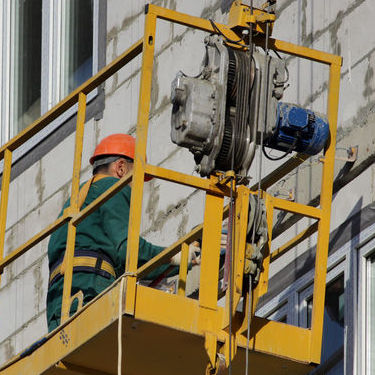Criteria for Suspended Scaffolds
General OSHA standard 1910.450 requirements for all types of suspension scaffolds include:
- Employers must ensure that all employees are trained to recognize the hazards associated with the type of scaffold being used. 1926.451(d)(1)
Scissor lifts are mobile supported scaffold work platforms used to safely move workers vertically and to different locations.
- All support devices must rest on surfaces capable of supporting at least four times the load imposed on them by the scaffold when operating at the rated load of the hoist, or at least one-and-a-half times the load imposed on them by the scaffold at the stall capacity of the hoist, whichever is greater. 1926.451(d)(1)
- A competent person must evaluate all direct connections prior to use to confirm that the supporting surfaces can support the imposed load, 1926.451(d)(1)
- All suspension scaffolds must be tied or otherwise secured to prevent them from swaying, as determined by a competent person. 1926.451(d)
- Guardrails, a personal fall arrest system, or both must protect each employee more than 10 feet (3.1 meters) above a lower level from falling. 1926.451(g)
- A competent person must inspect ropes for defects prior to each workshift and after every occurrence that could affect a rope's integrity. 1926.451(d)(10)
- When scaffold platforms are more than 24 inches (61 centimeters) above or below a point of access, ladders, ramps, walkways, or similar surfaces must be used. 1926.451(e)(1)
- When using direct access, the surface must not be more than 24 inches (61 centimeters) above or 14 inches (36 cm) horizontally from the surface. 1926.451(e)(8)
- When lanyards are connected to horizontal lifelines or structural members on single-point or two-point adjustable scaffolds, the scaffold must have additional independent support lines equal in number and strength to the suspension lines and have automatic locking devices. 1926.451(g)(3)(iii)
- Emergency escape and rescue devices must not be used as working platforms, unless designed to function as suspension scaffolds and emergency systems. 1926.451(d)(19)
Knowledge Check Choose the best answer for the question.
3-6. While working on a suspended scaffold, at what height must workers be protected with guardrails, personal fall arrest systems, or both?
You forgot to answer the question!

